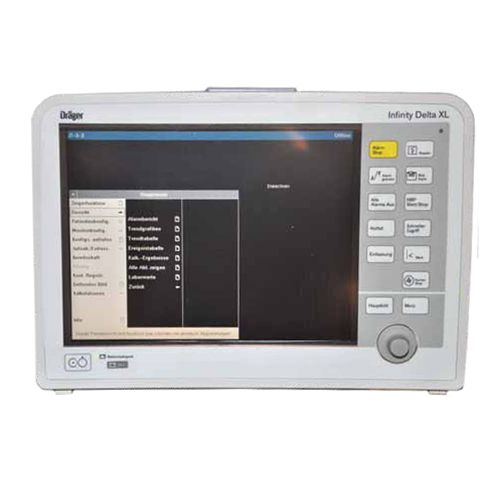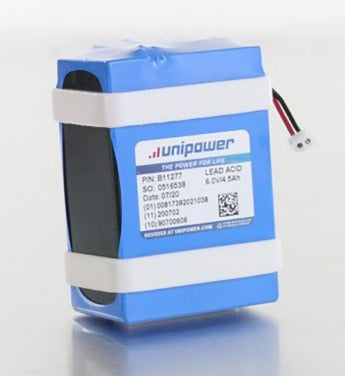Vital Signs Monitoring
Everyday more equipment arrives at our warehouse.
If you're looking for something, we can help! Give us a call at 1 (888) 228-7564 or shoot us an email anytime: Sales@IntegrisEquipment.com
Filter Vital Signs Monitoring
PASSPORT N CD (Base monitor - PASSPORT XG Units with Active Matrix Color TFT Display
PASSPORT IR XG (Adds two invasive BPs and recorder)
PASSPORT NR XG (Adds recorder)
PASSPORT I XG (Adds two invasive BPs)
PASSPORT N XG (Base monitor - PASSPORT XG Units with Brite 10.4" EL Display and Sidestream CO2*
PASSPORT IR XG (Adds two invasive BPs and recorder)
PASSPORT I XG (Adds two invasive BPs)
PASSPORT N XG (Base monitor - PASSPORT XG Units with Brite 10.4" EL Display
PASSPORT N CD CO2 (Base monitor- PASSPORT XG Units with Active Matrix Color TFT Display and Sidestream CO2*
PASSPORT N CD (Base monitor - PASSPORT XG Units with Active Matrix Color TFT Display
SIDESTREAM CO2 SENSOR KIT (Includes Sensor, Mainstream Reusable Airway Adapter and a Sidestream Starter Kit)
PASSPORT IR XG (Adds two invasive BPs and recorder)
PASSPORT NR XG (Adds recorder)
PASSPORT I XG (Adds two invasive BPs)
PASSPORT N XG (Base monitor - PASSPORT XG Units with Brite 10.4" EL Display and Sidestream CO2*
PASSPORT IR XG (Adds two invasive BPs and recorder)
PASSPORT N CD CO2 (Base monitor - PASSPORT XG Units with Active Matrix Color TFT Display and Sidestream CO2*
PASSPORT N CD CO2 (Base monitor - PASSPORT XG Units with Active Matrix Color TFT Display and Sidestream CO2*
PASSPORT N CD (Base monitor- PASSPORT XG Units with Active Matrix Color TFT Display
PASSPORT NR XG (Adds recorder)
PASSPORT NR XG (Adds recorder)
PASSPORT I XG (Adds two invasive BPs)
PASSPORT N XG (Base monitor - PASSPORT XG Units with Brite 10.4" EL Display

Drager Infinity Delta XL Vital Signs Patient Monitor + Warranty: 90-Day Warranty Included **Biomed Certified** Description: All of our products a...
View full details
Mindray VS8 - NEW From inpatient admissions to spot checks, the VS 8 Vital Signs Monitor unlocks the full potential of routine observations with ...
View full details
Mindray VS9 Vital Signs Monitor - NEW! Addressing the needs of low acuity areas, the VS9 is an easy-to-use vital signs monitor designed to elevate ...
View full details
B11277 WELCH-ALLYN SPOT VITAL SIGNS MONITOR BATTERY 4200-84 Condition: NEW - MFG warranty Part number: B11277 Manufacturer: Welch Allyn **BRA...
View full detailsVS8 Vital Signs Monitor, non-invasive blood pressure and pulse rate Nellcor OxiMax SpO2, Exergen Temporal Temp - Mindray 121-002165-00
VS8 Vital Signs Monitor, non-invasive blood pressure and pulse rate, Nellcor OxiMax SpO2 - Mindray 121-002160-00
VS8 Vital Signs Monitor, non-invasive blood pressure and pulse rate, Masimo SpO2, SmarTemp - Mindray 121-002161-00
VS8 Vital Signs Monitor, non-invasive blood pressure and pulse rate, Exergen Temporal Temp - Mindray 121-002163-00
VS8 Vital Signs Monitor, non-invasive blood pressure and pulse rate SmarTemp - Mindray 121-002158-00
VS8 Vital Signs Monitor, non-invasive blood pressure and pulse rate, Masimo SpO2, Exergen Temporal Temp - Mindray 121-002164-00
Vital Signs Patient Monitors
In this section of Integris Equipment, you can browse some of the new and refurbished vital signs monitors that we have for sale. Refurbished equipment comes with a 30 day Integris Bio-Med certified warranty.
Some of the parameters to look for when choosing a monitor are:
- NIBP - non invasive blood pressure
- SpO2 - pulse oximetery
- etCO2 - end-tidal CO2 (the level of carbon dioxide released at the end of expiration)
- Heartrate
- Temperature
- Printer
If you need any help choosing a vital signs monitor, feel free to call or email us, we will be happy to provide you with assistance.
Patient Monitors
A medical monitor or physiological monitor or display, is an electronic medical device that measures a patient's vital signs and displays the data so obtained, which may or may not be transmitted on a monitoring network. Physiological data are displayed continuously on a CRT or LCD screen as data channels along the time axis, They may be accompanied by numerical readouts of computed parameters on the original data, such as maximum, minimum and average values, pulse and respiratory frequencies, and so on.
In critical care units of hospitals, bedside units allow continuous monitoring of a patient, with medical staff being continuously informed of the changes in general condition of a patient. Some monitors can even warn of pending fatal cardiac conditions before visible signs are noticeable to clinical staff, such as atrial fibrillation or premature ventricular contraction (PVC).
Analog Monitoring
Old analog patient monitors were based on oscilloscopes, and had one channel only, usually reserved for electrocardiographic monitoring (ECG). So, medical monitors tended to be highly specialized. One monitor would track a patient's blood pressure, while another would measure pulse oximetry, another the ECG. Later analog models had a second or third channel displayed in the same screen, usually to monitor respiration movements and blood pressure. These machines were widely used and saved many lives, but they had several restrictions, including sensitivity to electrical interference, base level fluctuations, and absence of numeric readouts and alarms. In addition, although wireless monitoring telemetry was in principle possible (the technology was developed by NASA in the late 1950s for manned spaceflight) it was expensive and cumbersome.
Digital Monitoring
With the development of digital signal processing (DSP) technology, however, medical monitors evolved enormously, and all current models are digital, which also has the advantages of miniaturization and portability. Today the trend is toward multiparameter monitors that can track many different vital signs at once. The parameters (or measurements) now consist of pulse oximetry (measurement of the saturated percentage of oxygen in the blood, referred to as SpO2, and measured by an infrared finger cuff), ECG (electrocardiograph of the QRS waves of the heart with or without an accompanying external heart pacemaker), blood pressure (either invasively through an inserted blood pressure transducer assembly, or non-invasively with an inflatable blood pressure cuff), and body temperature through an adhesive pad containing a thermoelectric transducer. In some situations, other parameters can be measured and displayed, such as cardiac output (via an invasive Swan-Ganz catheter), capnography (CO2 measurements, referred to as EtCO2 or end-tidal carbon dioxide concentration), respiration (through a thoracic transducer belt, an ECG channel or via EtCO2, when it is called AWRR or airway respiratory rate), etc.
Besides the tracings of physiological parameters along time (X axis), digital medical monitors have automated numeric readouts of the peak and/or average parameters displayed on the screen, and high/low alarm levels can be set, which alert the staff when some parameter exceeds of falls the level limits, using audible signals.
Several models of multiparameter monitors are networkable, i.e., they can send their output to a central ICU monitoring station, where a single staff member can observe and respond to several bedside monitors simultaneously. Ambulatory telemetry can also be achieved by portable, battery-operated models which are carried by the patient and which transmit their data via a wireless data connection.
Monitor/Defibrillators
Some digital patient monitors, especially those used EMS services,often incorporate a defibrillator into the patient monitor itself. These monitor/defibrillators usually have the normal capabilities of an ICU monitor, but have manual (and usually semi-automatic AED)defibrillation capability. This is particular good for EMS services, who need a compact, easy to use monitor and defibrillator, as well as for inter- or intrafacility patient transport. Most monitor defibrillators also have transcutaneous pacing capability via large AED like adhesive pads (which often can be used for monitoring, defibrillation and pacing)that are applied to the patient in an anterior-posterior configuration. The monitor defibrillator units often have specialized monitoring parameters such as waveform capnography, invasive BP, and in some monitors, Masimo Rainbow SET pulse oximetry. Examples of monitor defibrillators are the Lifepak 12, 15 and 20 made by Physio Control, the Philips Heartstart MRx, and the E Series and R Series by ZOLL Medical.
In this section of Integris Epuipment, you will find a wide variety of patient monitors both new and refurbished.
***For any Patient Monitors not found on the website, please call or email***
888-228-7564
